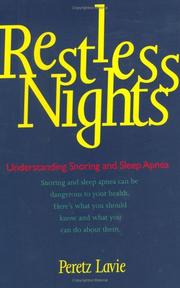| Listing 1 - 2 of 2 |
Sort by
|
Book
Year: 2003 Publisher: Bruxelles: UCL,
Abstract | Keywords | Export | Availability | Bookmark
 Loading...
Loading...Choose an application
- Reference Manager
- EndNote
- RefWorks (Direct export to RefWorks)
The sleepiness daytime denotes a propensity to fall asleep unintentionally during the day. The sleepiness increases reactions times, increases periods of non-responding or delays responding during attention-based tasks and reduces vigilance. This leads to increase the risk of road accidents, industrial accidents and accidents in the home when the sleepiness is maximum (from 3 till 5 in the morning and from 1 till 3 in the afternoon). There is a limited number of studies on habitual napping. This is most likely due to the relatively infrequent practise of daily naps in the most northern European and North American countries.
This study’s is to assess the effects of nap on sleepiness during afternoon in a population where napping is not a habit. The OSLER test estimates the sleepiness objectively. The pencil and paper tests (“Fluences verbales”, classic Buschke and Brown Peterson) are used to estimate the short-term and long-term memory. We compare these results during a control afternoon (no nap) with the results during an afternoon when the subjects are napping.
The results do not indicate a significant difference between these afternoons. Nevertheless, the major of observations indicates better answers during the afternoon with a nap La somnolence dénote une propension à tomber endormi au cours de la journée. La somnolence augmente le temps de réaction, augmente les périodes sans réponses ou retarde les réponses durant les tâches basées sur l’attention, réduit la vigilance. Ces troubles augmentent le risque d’accidents de la route, professionnels et domestiques aux heures où la somnolence est maximale (de 2 à 5 heures et de 13 à 15 heures). Un nombre limité d’études à été réalisé sur l’habitude d’effectuer des siestes. C’est probablement dû à une pratique relativement rare dans la plupart des pays d’Europe du Nord et d’Amérique du Nord.
L’objectif de cette étude est d’évaluer l’effet d’une sieste sur la somnolence au cours de l’après-midi dans une population qui ne fait pas la sieste d’habitude. La somnolence est appréciée objectivement par le test d’OSLER. Les tests « papier et crayon » (Fluences verbales, Buschke classique et Brown Peterson) sont utilisés pour estimer la mémoire à court terme et à long terme. Nous comparons les résultats de ces tests au cours d’une après-midi contrôle (sans sieste) avec les résultats récoltés au cours de l’après-midi où les sujets ont effectués une sieste.
Les résultats des tests ne montrent pas de différences significatives entre les deux après-midi. Néanmoins, la majorité des observations va dans le sens d’une amélioration des réponses pendant l’après-midi avec la sieste

ISBN: 1281729280 9786611729288 0300128959 9780300128956 9780300085440 0300085443 Year: 2003 Publisher: New Haven London
Abstract | Keywords | Export | Availability | Bookmark
 Loading...
Loading...Choose an application
- Reference Manager
- EndNote
- RefWorks (Direct export to RefWorks)
People with severe sleep apnea may struggle for breath all through the night, not breathing for as long as ninety seconds at a time during their sleep. This syndrome, which affects at least four percent of men and two percent of women, can cause daytime fatigue, traffic and work accidents, deteriorating cognitive abilities, and cardiovascular problems. Yet until now there has been no accessible discussion of the history, physiology, and risk factors of sleep apnea. In this book Peretz Lavie, an expert in sleep research, tells the complete story of sleep apnea for the first time.The book provides:• an explanation of the symptoms of sleep apnea, including the most important one, snoring;• an up-to-date description of the risk factors;• a clear explanation why sleep apnea causes cardiovascular problems;• a discussion of children's breathing disorders in sleep;• advice on how to get a consultation and diagnosis;• evaluations of the treatments currently available;• practical recommendations on how to live with the syndrome;• interviews with the key figures in sleep apnea research;• and more.
Sleep apnea syndromes. --- Snoring. --- Mouth breathing --- Hypersomnia with periodic respiration --- Mixed central and obstructive sleep apnea --- Mixed sleep apnea --- Obstructive sleep apnea --- Ondine's curse --- Sleep hypopnea --- Sleep-disordered breathing --- Apnea --- Sleep disorders --- Syndromes --- Sleep Apnea Syndromes --- Snoring --- Sleep apnea syndromes
| Listing 1 - 2 of 2 |
Sort by
|

 Search
Search Feedback
Feedback About UniCat
About UniCat  Help
Help News
News